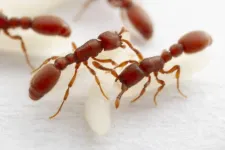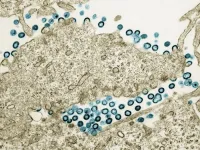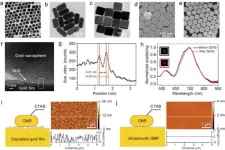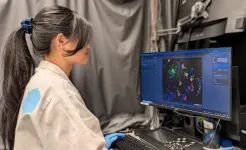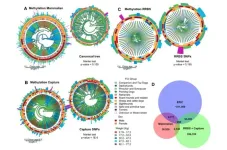(Press-News.org) A new automated system of monitoring and classifying persistent vibrations at active volcanoes can eliminate the hours of manual effort needed to document them.
Graduate student researcher Darren Tan at the University of Alaska Fairbanks Geophysical Institute led development of the system, which is based on machine learning. Machine learning is a branch of artificial intelligence focused on building systems that learn from data, identify patterns and make decisions with minimal human intervention.
Details about Tan’s automated system were published June 11 in the journal JGR Solid Earth.
His system documents volcanic tremor, a continuous, rhythmic seismic signal that emanates from a volcano. It often indicates underground movement of magma or gas and occurs regularly at active volcanoes.
Knowledge of volcanic tremor can help in forecasting and detecting eruptions.
Unlike volcanic earthquakes, volcanic tremor is a sustained ground rumble that can last from a few seconds to a year or more. It is primarily identified in spectrograms because of its varying intensity and frequency.
“Volcanic tremor isn’t typically detected or cataloged, because it tends to be quite subtle in the seismic data,” Tan said. “It doesn’t have the impulsive onset like an earthquake does.”
Detecting tremor is currently a manual process at the Alaska Volcano Observatory, with which Tan is also affiliated. The observatory is a joint program of the Geophysical Institute, the Alaska Division of Geological and Geophysical Surveys and the U.S. Geological Survey. Part of the observatory is based at the Geophysical Institute.
The observatory’s daily duty seismologist scans spectrograms at 32 volcano-monitoring networks across Alaska, looking for the slight indications of tremor in addition to the obvious seismic signals.
“The duty seismologists go in every day, and sometimes twice a day or more depending on the volcanic activity, to look at spectrograms,” Tan said. “They look from volcano to volcano, hour to hour, and it takes a long time.”
Alaska has 54 volcanoes classified as “historically active,” meaning they have erupted in the past approximately 300 years. Of those, 32 have seismic monitoring networks.
Tan drew upon the diversity of tremor signals from the 2021-2022 eruption of Pavlof Volcano, on the Alaska Peninsula, to build an extensive dataset of labeled seismic and low-frequency acoustic spectrograms. Those spectrograms represent a variety of classifications, such as tremor type, explosions and earthquakes, that were then used to train a computer model for each data type.
The trained models can detect and classify volcanic tremor in near real time. Humans will still be involved in interpreting what the automation produces, however.
“To be able to place our focus on time periods of interest, that is key,” Tan said. “I think that reinvents the way we can monitor long-duration eruptions, because things can get missed when a volcano is active for a year and a half or two years.”
“This automated method of detecting tremor is also an important contribution to the forecasting and detection of eruptions,” he said.
Tan said machine learning is a rapidly growing field with great possibilities.
“It’s like the Wild West of machine learning right now,” he said. “Everyone is trying to dip their toes into this, but it is important to do so carefully.”
UAF researchers among the seven co-authors of the journal paper include David Fee, Alaska Volcano Observatory coordinating scientist at the Geophysical Institute; Társilo Girona, Geophysical Institute research assistant professor; and research assistant professor Taryn Lopez, also of the Geophysical Institute.
Matthew Haney, Chris Waythomas and Aaron Wech at the USGS and former UAF postdoctoral researcher Alex Witsil, now at Applied Research Associates in North Carolina, are also co-authors.
The research was funded by the National Science Foundation’s Prediction of and Resilience against Extreme Events eruption forecasting project and the Alaska Volcano Observatory.
CONTACTS:
• Darren Tan, University of Alaska Fairbanks Geophysical Institute, ptan@alaska.edu
• Rod Boyce, University of Alaska Fairbanks Geophysical Institute, 907-474-7185, rcboyce@alaska.edu
END
UAF researcher creates way to detect elusive volcanic vibrations
2024-07-23
ELSE PRESS RELEASES FROM THIS DATE:
Lissajous pattern multi-pass cell: Enhancing high sensitivity and simultaneous dual-gas LITES sensing
2024-07-23
A new publication from Opto-Electronic Sciences; DOI 10.29026/oes.2024.240013 , discusses highly sensitive and real-simultaneous CH4/C2H2 dual-gas LITES sensor based on Lissajous pattern multi-pass cell.
Trace gases are atmospheric constituents with a volume fraction of less than 1%. Despite their low concentrations, nitrogen oxides, hydrocarbons, and sulfides in the atmosphere have a significant impact on the environment, closely related to phenomena such as acid rain, greenhouse effects, and ozone layer depletion. Therefore, race gas detection of is crucial for environmental ...
Asexual reproduction usually leads to a lack of genetic diversity. Not for these ants.
2024-07-23
Genetic diversity is essential to the survival of a species. It’s easy enough to maintain if a species reproduces sexually; an egg and a sperm combine genetic material from two creatures into one, forming a genomically robust offspring with two distinct versions of the species’ genome.
Without that combination of different genetic makeups, asexually reproducing species typically suffer from a lack of diversity that can doom them to a limited run on Earth. One such animal should be the clonal raider ant, which produces daughter after genetically identical daughter directly from an unfertilized ovum ...
Mini lungs make major COVID-19 discoveries possible
2024-07-23
Scientists at Sanford Burnham Prebys, University of California San Diego and their international collaborators have reported that more types of lung cells can be infected by SARS-CoV-2 than previously thought, including those without known viral receptors. The research team also reported for the first time that the lung is capable of independently mustering an inflammatory antiviral response without help from the immune system when exposed to SARS-CoV-2.
This work is especially timely, as cases of COVID-19 are on the rise in the scientists’ hometown of San Diego during a summertime spike. Looking beyond the region, more than half of the states in the country have reported “very ...
Exploratory analysis associates HIV drug abacavir with elevated cardiovascular disease risk in large global trial
2024-07-23
WHAT:
Current or previous use of the antiretroviral drug (ARV) abacavir was associated with an elevated risk of major adverse cardiovascular events (MACE) in people with HIV, according to an exploratory analysis from a large international clinical trial primarily funded by the National Institutes of Health (NIH). There was no elevated MACE risk for the other antiretroviral drugs included in the analysis. The findings will be presented at the 2024 International AIDS Conference (AIDS 2024) in Munich, Germany.
The Randomized Trial to Prevent Vascular Events in HIV (REPRIEVE) enrolled 7,769 study participants with HIV from 12 countries that found ...
Control of light–matter interactions in two-dimensional materials with nanoparticle-on-mirror structures
2024-07-23
A new publication from Opto-Electronic Sciences; DOI 10.29026/oes.2024.230051 , discusses control of light–matter interactions in two-dimensional materials with nanoparticle-on-mirror structures.
With the rapid development of high bit-rate wireless services driven by mobile internet, AI computing, high-definition videos, virtual reality/augmented reality (VAR) applications, and so on, the demand for wireless data rates has grown explosively in the past decades1, 2. Supporting such fast data rate at tens of Gbit/s pushes the carrier frequency to the THz (0.1-10 THz) ...
Does the onset of daylight saving time lead to an unhealthy lifestyle?
2024-07-23
Researchers from North Carolina State University, University of Manitoba, Bern University of Applied Sciences, University of South Carolina, and California Baptist University published a new Journal of Marketing study that explores whether the onset of daylight saving time leads consumers to engage in unhealthy behaviors.
The study, forthcoming in the Journal of Marketing, is titled “Spring Forward = Fall Back? The Effect of Daylight Saving Time Change on Consumers’ Unhealthy Behavior” and is authored by Ramkumar Janakiraman, Harsha ...
Best Paper awards lack transparency and do not increase equitability
2024-07-23
Research awards are an integral part of the universal “prestige economy” in science, but do they incentivize greater transparency, inclusivity, and openness? This study uses cross-disciplinary data to explore the level of transparency of publicly available award descriptions and assessment criteria, asking whether such awards contribute to or propagate existing reproducibility crises and inequities in science.
#####
In your coverage, please use this URL to provide access to the freely available paper in PLOS Biology: http://journals.plos.org/plosbiology/article?id=10.1371/journal.pbio.3002715
Article ...
Brain’s support cells contribute to Alzheimer’s disease by producing toxic peptide
2024-07-23
Oligodendrocytes are an important source of amyloid beta (Aβ) and play a key role in promoting neuronal dysfunction in Alzheimer’s disease (AD), according to a study published July 23, 2024 in the open-access journal PLOS Biology by Rikesh Rajani and Marc Aurel Busche from the UK Dementia Research Institute at University College London, and colleagues.
AD is a devastating neurodegenerative disorder affecting millions of people worldwide. Accumulation of Aβ – peptides consisting of 36 to 43 amino acids – ...
Co-analysis of methylation platforms for signatures of biological aging in the domestic dog
2024-07-23
“In this study, we explore the potential of the three largest, publicly available DNA methylation datasets in dogs to identify signals of biological age.”
BUFFALO, NY- July 23, 2024 – A new research paper was published in Aging (listed by MEDLINE/PubMed as "Aging (Albany NY)" and "Aging-US" by Web of Science) Volume 16, Issue 13, entitled, “Co-analysis of methylation platforms for signatures of biological aging in the domestic dog reveals previously unexplored confounding factors.”
Chronological age reveals the number of years an individual has lived since birth. By contrast, biological age varies between individuals of the same chronological ...
Mass layoffs and data breaches could be connected, according to researchers
2024-07-23
BINGHAMTON, N.Y. -- A research team led by faculty from Binghamton University, State University of New York has been exploring how mass layoffs and data breaches could be connected. Their theory: since layoffs create conditions where disgruntled employees face added stress or job insecurity, they are more likely to engage in risky behaviors that heighten the company’s vulnerability to data breaches.
The research, outlined in a paper titled “The Impacts of Layoffs Announcement on Cybersecurity Breaches,” was presented by Binghamton ...

